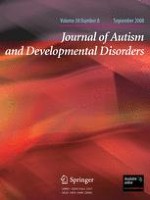01-09-2008 | Original Paper
Language Assessment and Development in Toddlers with Autism Spectrum Disorders
Gepubliceerd in: Journal of Autism and Developmental Disorders | Uitgave 8/2008
Log in om toegang te krijgenAbstract
One of the primary diagnostic criteria for the diagnosis of autism spectrum disorders (ASD) is the presence of a language delay or impairment. Children with ASD are now being identified at significantly younger ages, and prior research has consistently found that early language skills in this population are heterogeneous and an important predictor for later outcome. The goal of this study was to systematically investigate language in toddlers with ASD and to identify early correlates of receptive and expressive language in this population. The study included 164 toddlers with ASD between the ages of 18 and 33 months who were evaluated on several cognitive, language and behavioral measures. Results suggested good agreement among different measures of early language, including direct assessment and parent report measures. Significant concurrent predictors of receptive language included gestures, non-verbal cognitive ability and response to joint attention. For expressive language, the most significant predictors were non-verbal cognitive ability, gestures and imitation. These findings have important implications for intervention programs targeting this population.
